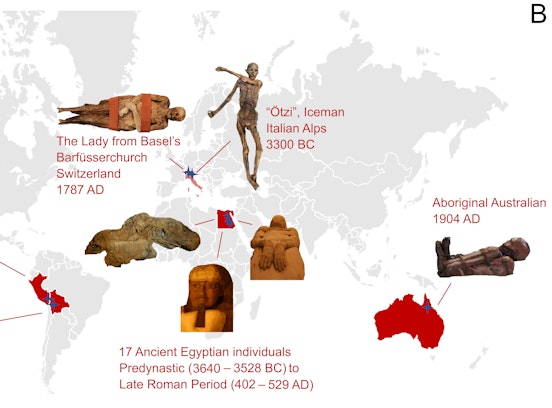Institute for Mummy Studies - News & Events - Two studies show atherosclerosis has been with humans for much longer than assumed
Two studies show atherosclerosis has been with humans for much longer than assumed
CT scans and genetic analyses of ancient human remains indicate that atherosclerosis has been present in humans for thousands of years.
- English
237 adult mummies from around the world were analyzed by the HORUS group, an international research team who were supported by Eurac Research experts. The study used computer tomography (CT) scans to detect atherosclerosis – it was present in more than 37 per cent of the mummies analyzed. In a separate study led by Christina Wurst a molecular geneticist from Eurac Research, the remains of 22 mummified individuals showed that different genetic risk factors for atherosclerosis were present in all the mummies examined. All this supports the assumption that people all over the world and at all times have suffered from the disease. The study by the HORUS group was recently published in the renowned European Heart Journal.
The studies examined mummies from more than seven different cultures spanning more than 5,000 years and included Ötzi the Iceman, mummies from ancient Egypt, pre-Columbian Peruvians from the lowlands and Bolivians from the Andes, 19th century Aleutian hunter-gatherers, 16th century Greenlandic Inuit, as well as mummies from the ancient Pueblo culture and medieval Gobi Desert cattle herders. The CT results of the Global HORUS study revealed definite or probable atherosclerosis, marked by calcifications in the arterial walls, in more than a third of the individuals.
As ancient DNA is only present in tiny fragments mixed with the genetic material of other organisms, the research team, led by Christina Wurst from Eurac Research, used a specially developed targeted enrichment capture approach to fish out the genetic variants they were looking for from the DNA mixture. This analysis, which was published in the Annals of Global Health journal, was supplemented by a weighted polygenic risk score to determine the individual genetic predisposition to developing the disease.
The HORUS study, which used CT scans to analyse calcifications, provided an important confirmation of Christina Wurst's genetic findings: the mummies with the most pronounced genetic predisposition to atherosclerosis were also those with calcifications in the arteries. This shows that the genomic method is consistent and can also be applied to skeletons in the future, which are much more frequently available to researchers than mummies.
“We found atherosclerosis in all time periods in both men and women, in all seven cultures that were studied, and in both elites and non-elites,” said Randall Thompson, MD, lead author of the Global Horus study and cardiologist at Saint Luke’s Mid America Heart Institute.
“We see that atherosclerosis is not a disease of affluence: Ötzi was one of two mummies with the clearest genetic predisposition to atherosclerosis and he died 5300 years ago, so we have been carrying this predisposition for at least that long,” Christina Wurst, molecular geneticist at the Eurac Research Institute for Mummy Studies underlined.
Find the complete information here:
https://academic.oup.com/eurheartj/article-lookup/doi/10.1093/eurheartj/ehae283
